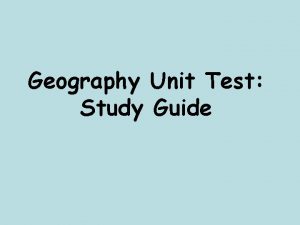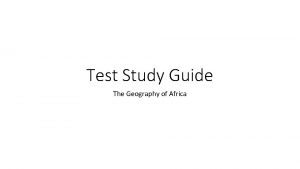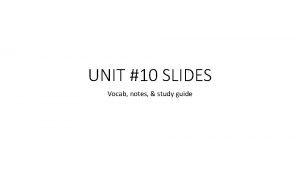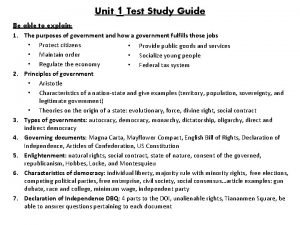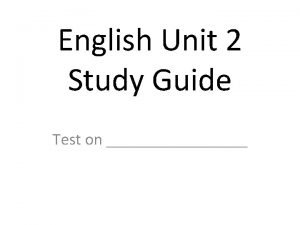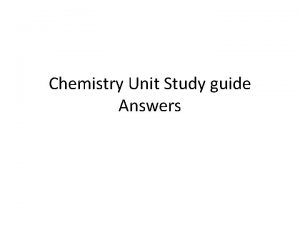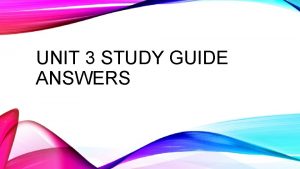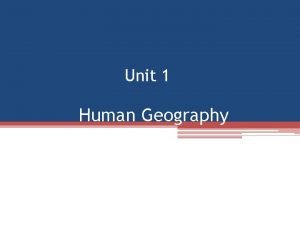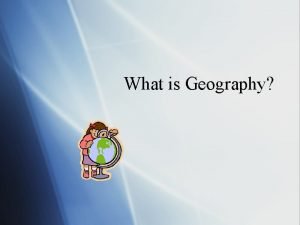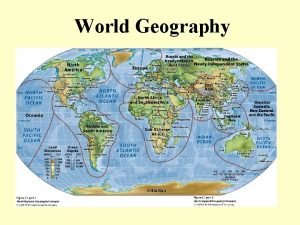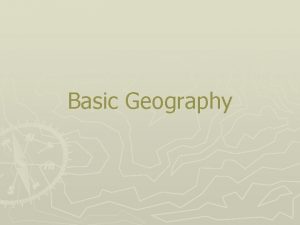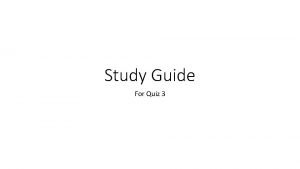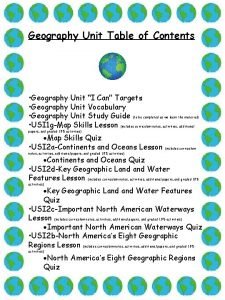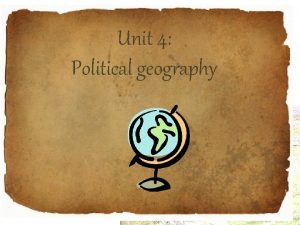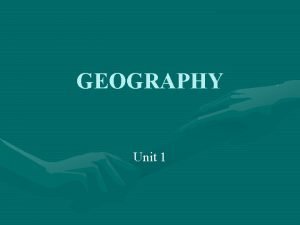Unit 1 Geography Study Guide What to study










- Slides: 10

Unit 1 Geography Study Guide What to study!

Culture & Cultural Diffusion • Definition of Culture • A way of life of a group of people who share beliefs and similar customs. • Ethnic Group • Group of people who share common ancestry, language, religion and customs. • Cultural Diffusion • The spread of new knowledge and skills from one culture to another.

Government Systems • Authoritarian government • Any type of government in which no or little individual freedom is allowed; North Korea, Hitler, Stalin, Mao • Government that gives people the most political freedom • Republic • U. S. Government System • Democratic Republic • Government Run by the few • Oligarchy • Country with a Constitutional Monarchy • Great Britain

Economic Systems • Definition of Economic Systems • How a country deals with production, distribution, and consumption of goods and services • Economy that does not use money but rather trade goods with one another • Traditional Economy • An economy where the people determine what goods and services are produced and how they are distributed • Capitalist Economy • This economy is high risk, high reward, and has an uneven wealth distribution • An economy where the government determines what goods and services are produced and how they are distributed • Communist Economy • In this economic system there is very little incentive to work, a low standard of living and few personal choices • An economy in which a government takes over major industries but still allows private industries to exist • Socialist Economy • This economy is associated with very high taxes and increased government assistance

Physical Geography • Plate Tectonics • The idea that the earth’s crust is made of large, moving slabs of rock • Reasons that support the idea of a supercontinent (Pangaea) • Fossils found on one continent match fossils found on other continents • The continents fit together like puzzle pieces • Volcanoes and earthquakes are most likely to occur • Where plates collide or pull apart (fault lines)

Internal Forces • Example of Internal Forces • Earthquakes and Volcanoes

External Forces • Example of External Forces • • Mechanical Weathering Wind Erosion Water Erosion Glacial Movement

Boimes • The biome is found at higher latitudes (furthest from the equator) • Tundra • The biome which the vegetation depends upon its elevation • Alpine/Mountain • The biomes that can co-exist next to each other (they have to be at the same elevation) • Tropical Rainforest and Savana

• Defining Characteristics of Culture: • • • Language Religion Social Groups Government Economy • Cultural Diffusion • Why does it happen • Economies • What impact do they have on peoples lives • Biomes • Be able to describe at least 3 ways people in a specific area have adapted their lives to that biome. • Remember that biomes include climate, physical features, weather, location, vegetation, etc. )

The maps • Make sure you can map: • Continents and Oceans • Lines of Latitude (Arctic Circle and Antarctic Circle, Tropic of Cancer and Capricorn, Equator) and the Line of Longitude • Mountains (Andes, Ural, Himalayan & Mt. Everest, Rocky Mt. , Alps, and Mt. Kilimanjaro) • Deserts (Gobi, Atacama, and Sahara) • Rainforests (Amazon & Congo) • Panama Canal, Suez Canal, & Siberia • Rivers (Amazon, Ganges, Nile, Tigris, Euphrates, Mississippi, Congo, and Indus) • Big Bodies of Water (Caspian Sea, Lake Baikal, Yellow River, English Channel, Mediterranean, Black Sea, Baltic Sea, Red Sea, Persian Gulf, Gulf of Mexico, Caribbean Sea)
 Africa geography unit test study guide
Africa geography unit test study guide Africa geography unit test study guide
Africa geography unit test study guide World history final exam study guide
World history final exam study guide Unit 10 study guide answer key
Unit 10 study guide answer key Unit 1 test 2
Unit 1 test 2 Hydrology unit study guide
Hydrology unit study guide English test unit 2
English test unit 2 Chemistry unit 1 study guide
Chemistry unit 1 study guide Unit 3 study guide math
Unit 3 study guide math Unit 3 study guide answers
Unit 3 study guide answers Government study guide unit 1
Government study guide unit 1
